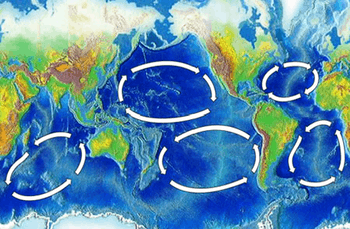North Atlantic garbage patch

The North Atlantic garbage patch is an area of man-made marine debris found floating within the North Atlantic Gyre, originally documented in 1972.[1] The patch is estimated to be hundreds of kilometres across in size,[2] with a density of over 200,000 pieces of debris per square kilometer.[3][4] The debris zone shifts by as much as 1,600 km (990 mi) north and south seasonally, and drifts even farther south during the El Niño-Southern Oscillation, according to the NOAA.[2] There also is a South Atlantic garbage patch.
Research
To study the scale of the marine debris accumulation in the area, the Sea Education Association (SEA) has been doing extensive research on the Atlantic Garbage Patch. Nearly 700,000 students from the SEA semester program have been dragging 6,100 fine-mesh nets through the Atlantic over 23 years. The gyre in the North Atlantic Ocean contains plastic marine pollution in a pattern and amount similar to what has been found in the Great Pacific Garbage Patch.[5] Nikolai Maximenko of the University of Hawaii in Honolulu has been conducting research on the currents carrying the trash between Hawaii, the Great Pacific Garbage Patch, and gyres in the Atlantic.[6]
Effect on wildlife and humans
While eating their normal source of food, plastic ingestion can be unavoidable to wildlife, and several specimens have been found dead with copious amounts of indigestible trash in their bodies. Wildlife killed by ingestion of plastic that do not wash up on shore ultimately decompose in the ocean, re-releasing the plastics into the ecosystem to be consumed again.[7][8][9] Although the patch is barely visible from overhead, as much as 70% of the trash is estimated to be on the ocean floor, where Microplastics only millimeters wide impact sealife at nearly every level of the food chain.[10][11][12] The plastics also carry hazardous microbes not commonly found in the environment, furthering their toxic effect on marine wildlife.[13] Humans eventually consume sea life, ingesting the same toxins and plastics consumed by the wildlife.
Awareness and Clean-up Efforts

On 11 April 2013 in order to create awareness, artist Maria Cristina Finucci founded The Garbage Patch State at UNESCO[14] –Paris in front of Director General Irina Bokova . The federally recognized Garbage Patch State spans over 16,000,000 kilometers and includes all 5 oceanic garbage patch islands.[15] This was the first of a series of events under the patronage of UNESCO and of Italian Ministry of the Environment, sparking.a series of art exhibits across the world used to bring attention to the size and severity of the garbage patches and incite awareness and action.[16] Because so much of the plastic has deteriorated to a small size, major clean up efforts have been deemed "impossible... without also removing the sea organisms." [17] Dutch inventor Boyan Slat and his nonprofit organization The Ocean Cleanup have been developing technology to clean the oceans of plastic by herding larger pieces together for more efficient removal. Cleanup is planned to start in the Great Pacific Garbage Patch first, and eventually move around to the other patches across the globe.[18]
See also
References
- ↑ Carpenter, E.J.; Smith, K.L. (1972). "Plastics on the Sargasso Sea Surface, in Science". Science. 175 (4027): 1240–1241. doi:10.1126/science.175.4027.1240. PMID 5061243.
- 1 2 Steve, By (4 August 2009). "Scientists study huge ocean garbage patch". Perthnow.com.au. Retrieved 10 May 2012.
- ↑ "Scientists find giant plastic rubbish dump floating in the Atlantic". Perthnow.com.au. 26 February 2010. Archived from the original on 14 April 2012. Retrieved 10 May 2012.
- ↑ Gill, Victoria (24 February 2010). "Plastic rubbish blights Atlantic Ocean". BBC News. Retrieved 10 May 2012.
- ↑ "Huge Garbage Patch Found in Atlantic Too". News.nationalgeographic.com. 2 March 2010. Retrieved 10 May 2012.
- ↑ "Shibboleth Authentication Request". search-proquest-com.libproxy1.usc.edu. Retrieved 2018-04-19.
- ↑ "Plastic pollution found inside dead seabirds".
- ↑ "Our Trash is enough to Kill a whale" CBS 12 news. Author Jana Eschbach. October 15, 2015
- ↑ "Pygmy sperm whale died in Halifax Harbour after eating plastic".
- ↑ Perkins, Sid (17 December 2014). "Plastic waste taints the ocean floors". Nature.
- ↑ Handwerk, Brian (2009). "Giant Ocean-Trash Vortex Attracts Explorers". National Geographic.
- ↑ "The present and future of microplastic pollution in the marine environment". Environmental Pollution. 185: 352–364. 2014-02-01. doi:10.1016/j.envpol.2013.10.036. ISSN 0269-7491.
- ↑ "Plastics in the North Atlantic garbage patch: A boat-microbe for hitchhikers and plastic degraders". Science of the Total Environment. 599-600: 1222–1232. 2017-12-01. doi:10.1016/j.scitotenv.2017.05.059. ISSN 0048-9697.
- ↑ "The garbage patch territory turns into a new state - United Nations Educational, Scientific and Cultural Organization". unesco.org.
- ↑ "The Garbage e=it". Retrieved 2018-04-19.
- ↑ "Archived copy". Archived from the original on 14 July 2014. Retrieved 3 November 2014.
- ↑ "F.a.q. - Frequently Asked Question about Garbage Parch State". www.garbagepatchstate.org (in Italian). Retrieved 2018-04-19.
- ↑ www.theoceancleanup.com, The Ocean Cleanup,. "www.theoceancleanup.com". The Ocean Cleanup. Retrieved 2018-04-19.